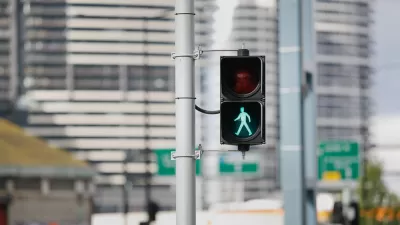The latest from a growing body of research on the connections between land use and public health identifies four characteristics of land use that produce beneficial public health outcomes.
"Scientists are learning more and more about how where we live affects the amount of exercise we get, and thus how fit and healthy we are likely to be," according to an article by F. Kaid Benfield.
Supplementing Benfield's assessment of the body of research on the subject is a new study by Professor James F. Sallis of the University of California, San Diego and a team of 21 researchers, who examined physical activity data on 6,822 adults, from 14 cities in ten countries.
The study found four land use factors "to be directly and independently significant with respect to exercise," according to Benfield. The four factors: 1) residential density, 2) intersection density, 3) public transport density, and 4) access to parks.
Benfield unpacks some of the nuances of those findings, especially regarding the last of those features. "I believe [parks] are understudied in the urbanist circles that I inhabit," writes Benfield.
Benfield also offers a hat tip to Christopher Bergland, who broke the news regarding the study for Psychology Today.
FULL STORY: Four Characteristics of Active, Healthy Neighborhoods

Maui's Vacation Rental Debate Turns Ugly
Verbal attacks, misinformation campaigns and fistfights plague a high-stakes debate to convert thousands of vacation rentals into long-term housing.

Planetizen Federal Action Tracker
A weekly monitor of how Trump’s orders and actions are impacting planners and planning in America.

In Urban Planning, AI Prompting Could be the New Design Thinking
Creativity has long been key to great urban design. What if we see AI as our new creative partner?

King County Supportive Housing Program Offers Hope for Unhoused Residents
The county is taking a ‘Housing First’ approach that prioritizes getting people into housing, then offering wraparound supportive services.

Researchers Use AI to Get Clearer Picture of US Housing
Analysts are using artificial intelligence to supercharge their research by allowing them to comb through data faster. Though these AI tools can be error prone, they save time and housing researchers are optimistic about the future.

Making Shared Micromobility More Inclusive
Cities and shared mobility system operators can do more to include people with disabilities in planning and operations, per a new report.
Urban Design for Planners 1: Software Tools
This six-course series explores essential urban design concepts using open source software and equips planners with the tools they need to participate fully in the urban design process.
Planning for Universal Design
Learn the tools for implementing Universal Design in planning regulations.
planning NEXT
Appalachian Highlands Housing Partners
Mpact (founded as Rail~Volution)
City of Camden Redevelopment Agency
City of Astoria
City of Portland
City of Laramie





























